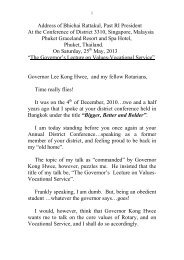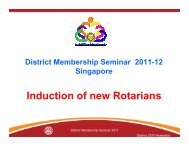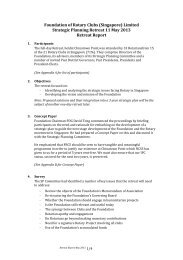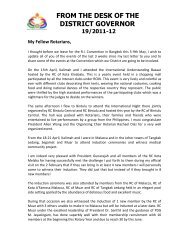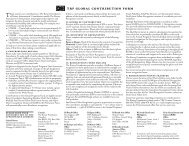haemodialysis_quality_standards - Rotary International District 3310
haemodialysis_quality_standards - Rotary International District 3310
haemodialysis_quality_standards - Rotary International District 3310
You also want an ePaper? Increase the reach of your titles
YUMPU automatically turns print PDFs into web optimized ePapers that Google loves.
CHAPTER 5: WATER QUALITY<br />
5.1 Dialysis water shall be produced by the process of Reverse Osmosis.<br />
5.2 The minimum <strong>standards</strong> indicated below is based on the ISO 23500: 2011<br />
5.3 Chemical Contaminants<br />
5.3.1 Permissible levels of chemical contaminants shall be observed and<br />
adhered to. (See Appendix 2)<br />
5.3.2 Method of Testing<br />
<br />
<br />
Chlorine and Chloramines and water hardness testing shall be<br />
performed onsite using commercially available test kits.<br />
Full analysis for chemical contaminants shall be performed by an<br />
accredited laboratory.<br />
5.3.3 Minimum Frequency of Testing<br />
<br />
<br />
Daily using commercially available test kits for chlorine and<br />
chloramines.<br />
Six (6)-monthly testing in an accredited laboratory for chemical<br />
analysis.<br />
5.3.4 Site of Testing<br />
<br />
<br />
<br />
Daily testing for Chlorine and Chloramines shall be done after<br />
each carbon column.<br />
Daily testing for hardness after softener column.<br />
Six (6)-monthly full laboratories testing for chemicals shall be<br />
done at raw water point, pre and post RO.<br />
5.3.5 Action if limits exceeded<br />
Evaluate water treatment system and rectify as necessary.<br />
Haemodialysis Quality and Standards 25



